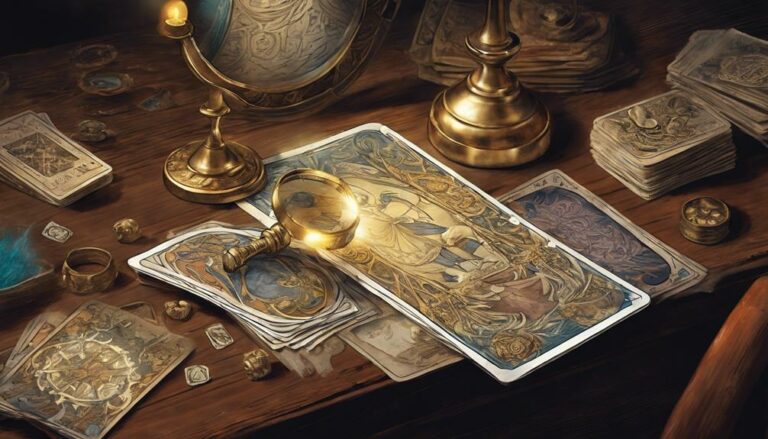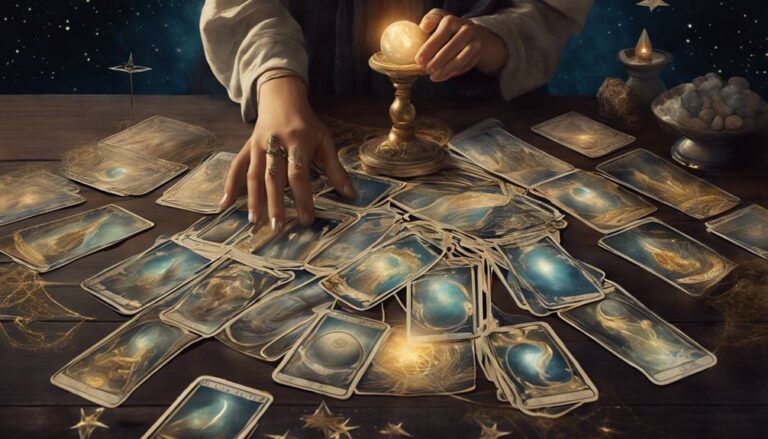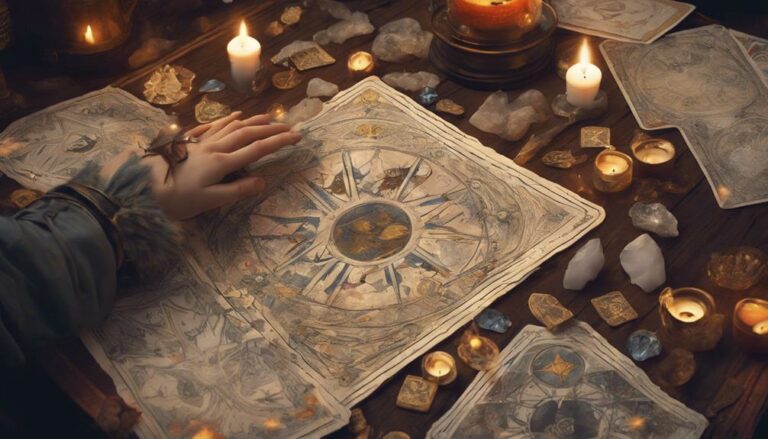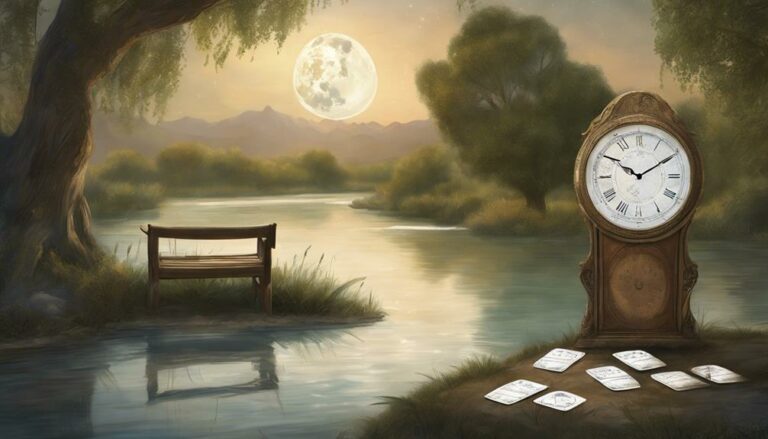In my journey as a tarot card enthusiast and advisor, I’ve often found myself captivated by the rich history and mystique surrounding these powerful divination tools. Tarot cards, with their intricate symbols and deep meanings, have fascinated people for centuries. In this article, we will embark on a journey to trace the origins of tarot card decks, exploring their evolution, symbolism, and enduring appeal. Join me as we delve into the intriguing world of tarot.
Table of Contents
ToggleIntroduction
Welcome to the enchanting world of tarot cards, where ancient wisdom and modern curiosity intersect. As an avid tarot enthusiast and advisor, I’ve had the privilege of witnessing the transformative power of these magical decks. In this article, we will embark on a captivating journey to trace the origins of tarot card decks, peeling back the layers of time to reveal their intriguing history and enduring significance.
The allure of tarot cards lies not only in their ability to predict the future but also in their capacity to illuminate the depths of our souls. For centuries, these enigmatic cards have been both a source of guidance and a mirror to our innermost thoughts and desires. Whether you’re a seasoned practitioner or a curious novice, join me as we unravel the secrets of tarot and uncover the stories hidden within each card.
We’ll explore how tarot cards transitioned from humble playing cards in Renaissance Italy to become powerful instruments of divination and self-discovery. Along the way, we’ll delve into the symbolism that infuses every card, the archetypal journey they represent, and their universal appeal that transcends cultures and borders.
So, fasten your seatbelt, open your mind, and prepare to be transported through time and space as we embark on a quest to understand the mystical origins of tarot card decks. Let’s dive deep into the arcane, where the past meets the present and the future unfolds in the shuffle of the cards.

The Beginnings of Tarot
To grasp the essence of tarot, we must journey back to a time when these cards were mere playthings in the courts of Renaissance Italy. Our story begins in the 15th century, a period marked by artistic flourishing and cultural transformation.
At that time, tarot decks were not the revered tools of divination they are today. Instead, they were created for amusement, used in a game called “tarocchi” or “triumphs.” The first known tarot deck, the Visconti-Sforza, commissioned by the Duke of Milan, serves as a testament to the era’s fusion of artistry and card-playing. Its intricate designs and symbolic imagery hinted at a deeper potential waiting to be unlocked.
As we explore the origins of tarot, we’ll uncover the transition from gaming cards to a conduit for spiritual insight. The seeds of transformation were sown during this era, setting the stage for tarot’s evolution into a powerful instrument of divination and self-discovery. Join me on this historical voyage as we navigate the intricate tapestry of tarot’s beginnings.
The Tarot’s Transformation
The 18th century marked a pivotal turning point in the history of tarot cards. It was during this era that tarot underwent a profound transformation, evolving from a simple deck of playing cards into a repository of esoteric wisdom and spiritual insight. French occultists, such as Etteilla and Eliphas Levi, played a significant role in this metamorphosis.
Etteilla, whose real name was Jean-Baptiste Alliette, is often credited as the first person to use tarot cards for divination purposes systematically. He published a book titled “Etteilla, ou L’art de tirer les cartes” (Etteilla, or the Art of Reading Cards) in 1785, in which he outlined his interpretations of the tarot cards and their symbolism. This marked the beginning of tarot as a tool for spiritual guidance and introspection.
Eliphas Levi, a French magician and occultist, further contributed to the esoteric interpretation of tarot. He integrated Kabbalistic and Hermetic concepts into tarot symbolism, adding layers of depth and mysticism to the cards. Levi’s influence can be seen in the symbolism and imagery of many modern tarot decks.
However, one of the most iconic and influential tarot decks in history, the Rider-Waite Tarot deck, was created in the early 20th century. Designed by Pamela Colman Smith and A.E. Waite in 1910, this deck departed from traditional tarot imagery and introduced a more intuitive and accessible approach to tarot reading. The Rider-Waite Tarot deck’s imagery and symbolism have become the standard for many contemporary tarot decks and remain immensely popular today.

The Symbolism Within Tarot
At the heart of every tarot deck lies a captivating world of symbolism and meaning. Each card, whether from the Major Arcana or the Minor Arcana, is a canvas adorned with intricate imagery that holds profound significance. As we delve deeper into the symbolism within tarot, we begin to unlock the secrets and wisdom these cards have to offer.
Major Arcana: Unveiling Life’s Secrets
The Major Arcana, often referred to as the “trump cards,” are the soul of the tarot deck. These 22 cards represent pivotal life experiences and archetypal journeys that resonate with us on a deep, universal level. Let’s explore a few key Major Arcana cards to understand their symbolism:
The Fool (0)
The Fool is the embodiment of new beginnings and adventures. It signifies the free spirit within us, unburdened by past experiences. The Fool encourages us to take risks, embrace change, and trust the journey ahead.
The Lovers (VI)
The Lovers card represents the power of choice and connection. It symbolizes not only romantic love but also the choices we make in relationships, partnerships, and unions. This card encourages us to align with our true desires and values.
The Death (XIII)
Contrary to its ominous name, The Death card signifies transformation and rebirth. It urges us to let go of old patterns and beliefs that no longer serve us, making way for new opportunities and growth.
Exploring the Major Arcana is like embarking on an epic hero’s journey, where each card offers a unique lesson and insight into the human experience.
Minor Arcana: Daily Reflections
While the Major Arcana deals with significant life events and spiritual awakenings, the Minor Arcana provides practical guidance for our everyday lives. Divided into four suits—Wands, Cups, Swords, and Pentacles—the Minor Arcana addresses various aspects of our existence:
Wands
Wands represent the realm of passion, creativity, and inspiration. They encourage us to pursue our dreams with enthusiasm and take action on our goals.
Cups
Cups delve into the world of emotions, love, and relationships. These cards help us navigate the complexities of our feelings and connections with others.
Swords
Swords embody the realm of thoughts, challenges, and conflicts. They prompt us to confront our fears, address obstacles, and seek clarity.
Pentacles
Pentacles focus on the material and practical aspects of life, including finances, career, and health. They guide us in making grounded and sustainable decisions.
The symbolism within the Minor Arcana cards is a mirror reflecting the ups and downs of our daily existence, offering insights and advice for navigating life’s challenges and opportunities.

The Tarot’s Universal Appeal
One of the most fascinating aspects of tarot cards is their ability to transcend cultural boundaries, beliefs, and generations. The universal appeal of tarot lies in its profound symbolism, innate wisdom, and its capacity to speak to the human experience on a deeply personal level.
A Language of Symbols
At its core, tarot is a language of symbols. These symbols are not bound by spoken words or written text; they communicate directly with the subconscious mind. This universal language makes tarot accessible to people from all walks of life, regardless of their native tongue or cultural background. Whether you’re in Tokyo or New York, the image of The Fool or The Tower conveys a story and evokes emotions that resonate universally.
A Mirror to the Soul
Tarot serves as a mirror to the soul, reflecting our innermost thoughts, desires, and fears. It taps into the collective consciousness, where human experiences and emotions are shared by people across the globe. When you draw a card and see your own struggles, hopes, and aspirations mirrored in its imagery, it’s a reminder that we’re all connected in the tapestry of the human experience.
A Tool for Self-Reflection
In a world filled with noise and distractions, tarot offers a space for quiet introspection. Whether you’re seeking answers to life’s big questions or simply looking for guidance in daily decisions, tarot provides a framework for self-reflection. It encourages us to pause, connect with our intuition, and explore our inner landscape—a practice that resonates universally with those seeking clarity and understanding.
Bridging Generations
Tarot’s enduring appeal is also evident in its ability to bridge generations. While the roots of tarot date back centuries, it continues to captivate and inspire people of all ages. Young adults explore tarot as a tool for self-discovery, while older generations may view it as a source of wisdom and guidance accumulated over a lifetime. The timeless nature of tarot ensures that its allure remains undiminished by the passage of time.
A Shared Journey
Ultimately, the universal appeal of tarot is rooted in its ability to unite people in a shared journey of self-discovery and growth. Whether you’re a skeptic or a devoted believer, tarot offers a space for exploration and dialogue. It invites us to embrace our humanity, acknowledge our strengths and weaknesses, and recognize that, beneath our surface differences, we all share common hopes, dreams, and questions about the mysteries of life.
Modern Tarot Practices
In the 21st century, tarot has experienced a resurgence in popularity and adaptation to the fast-paced, digitally connected world we live in. Modern tarot practices have evolved to meet the needs of a global audience, making this ancient art more accessible and relevant than ever before. Here, we’ll explore some of the contemporary ways in which tarot is practiced and embraced.
Online Tarot Readings
The internet has opened doors to a world of possibilities for tarot enthusiasts and professional readers alike. Online tarot readings have become increasingly popular, allowing seekers from around the globe to connect with skilled readers via video calls or chat platforms. This accessibility has broadened the reach of tarot, making it easier for individuals to seek guidance and insight regardless of their physical location.
Tarot Apps and Software
In our tech-savvy era, tarot has found its way into the digital realm through tarot apps and software. These applications often feature virtual tarot decks, card spreads, and interpretations. Tarot enthusiasts can now carry their decks in their pockets and receive instant readings at their convenience. While these apps may lack the tactile experience of physical cards, they provide a practical tool for on-the-go divination and self-reflection.
Online Tarot Courses and Communities
The digital age has also given rise to online tarot courses and communities. Tarot practitioners can now access a wealth of educational resources, from beginner’s guides to advanced tarot courses, all from the comfort of their own homes. Online forums and social media groups connect like-minded individuals, fostering a sense of community and providing a platform for sharing insights, experiences, and card interpretations.
Virtual Tarot Events
Tarot events, workshops, and conferences have embraced the virtual realm, allowing attendees to participate from anywhere in the world. These events feature renowned tarot experts, offering a unique opportunity to learn from masters of the craft and gain deeper insights into the symbolism and techniques of tarot reading.
Tarot as a Tool for Self-Reflection
In the fast-paced, often chaotic world we live in, finding moments of stillness and self-reflection can be a challenge. This is where tarot steps in as a valuable and accessible tool for deep introspection and personal growth.
Daily Tarot Card Pulls
One of the simplest yet most effective ways to use tarot for self-reflection is through daily card pulls. Each morning, you can draw a single card from your deck, setting the intention to gain insight into the day ahead. As you gaze at the card’s imagery, pay attention to your initial impressions and emotions it evokes. What messages does it hold for you today? This practice encourages mindfulness and helps you start your day with intention and awareness.
Journaling with Tarot
Pairing tarot with journaling is a powerful means of self-exploration. After drawing a card, take a few moments to write down your thoughts, feelings, and associations related to that card. Consider questions like: How does this card relate to my current situation? What does it reveal about my emotions or challenges today? Journaling not only deepens your connection with the cards but also provides a space to express and process your inner world.
Thematic Readings
For those seeking to explore specific aspects of their lives or emotions, thematic tarot readings can be immensely helpful. You can create spreads or choose cards that focus on topics such as relationships, career, personal growth, or spirituality. By tailoring your readings to your current concerns, you can gain valuable insights and guidance in those areas where you seek clarity or transformation.
Meditation with Tarot
Meditation is a powerful practice for stilling the mind and connecting with your inner self. Combining meditation with tarot involves selecting a card and using it as a focal point for your meditation session. Allow the imagery and symbolism of the card to guide your thoughts and lead you to a deeper understanding of yourself and your life’s path. This practice can be particularly beneficial for those seeking spiritual or intuitive growth.
Tracking Progress and Patterns
Consistent tarot practice allows you to track your progress and observe patterns in your life. By keeping a tarot journal or diary of your readings, you can look back over time and see how your interpretations and perceptions have evolved. This reflection can offer profound insights into your personal growth journey and the changes you’ve experienced.
Tarot as a tool for self-reflection is not about predicting the future but rather about gaining clarity, insight, and a deeper connection to your inner wisdom. It encourages you to pause, listen to your intuition, and explore the vast landscapes of your emotions, thoughts, and desires. Whether you’re seeking daily guidance or embarking on a journey of self-discovery, tarot is a faithful companion that can help illuminate the path ahead and the depths within.
Conclusion
As we conclude our journey into the mystical realm of tarot card decks, we find ourselves standing at the intersection of history, symbolism, and self-discovery. Tarot, with its origins dating back to Renaissance Italy, has transcended time and culture to become a timeless source of guidance, introspection, and inspiration.
We’ve traced the humble beginnings of tarot as playing cards and witnessed their transformation into powerful tools for divination and self-reflection, thanks to the contributions of visionaries like Etteilla, Eliphas Levi, and the iconic Rider-Waite Tarot deck. We’ve delved deep into the symbolism within tarot, exploring the profound insights offered by the Major Arcana and the practical wisdom of the Minor Arcana.
The universal appeal of tarot has united people across the globe, regardless of language or background, in a shared journey of self-discovery. Tarot’s symbolic language and the mirror it holds to our souls have allowed us to connect with the collective consciousness and find common ground in our human experiences.
In the modern age, tarot has seamlessly adapted to our digitally connected world. Online readings, tarot apps, virtual events, and vibrant online communities have made tarot more accessible than ever. Tarot has also become a valuable tool for daily self-reflection, offering moments of mindfulness and personal growth.
As we part ways, let us remember that tarot is not just a deck of cards; it’s a gateway to self-knowledge, a compass for navigating life’s twists and turns, and a mirror reflecting our deepest desires and fears. Whether you’re a seasoned practitioner or a curious beginner, may tarot continue to be a source of wonder, guidance, and illumination on your unique life journey.
So, as you shuffle the cards and draw the next chapter of your story, remember that the magic of tarot lies not only in the cards but in the profound connection it fosters between you and the mysteries of the universe. Embrace the wisdom of the cards, trust your intuition, and may your path be filled with insight, growth, and endless discovery.
FAQs (Frequently Asked Questions)
Can anyone learn to read tarot cards?
Absolutely! Tarot is accessible to anyone with an interest in learning. It’s all about tapping into your intuition and connecting with the symbolism of the cards.
Are tarot readings accurate?
Tarot readings are a tool for insight and guidance, but their accuracy can vary. It depends on the reader’s skill and the seeker’s openness to interpretation.
How do I choose the right tarot deck?
Choosing a tarot deck is a personal journey. Go with one that resonates with you visually and intuitively. The Rider-Waite deck is a popular choice for beginners.
Can tarot predict the future?
Tarot doesn’t predict the future with certainty. Instead, it offers insights and potential outcomes based on current energies and choices.
Is it necessary to have psychic abilities to read tarot?
No, psychic abilities are not required to read tarot cards. Tarot readers use intuition and symbolism to interpret the cards, and anyone can develop these skills over time.










